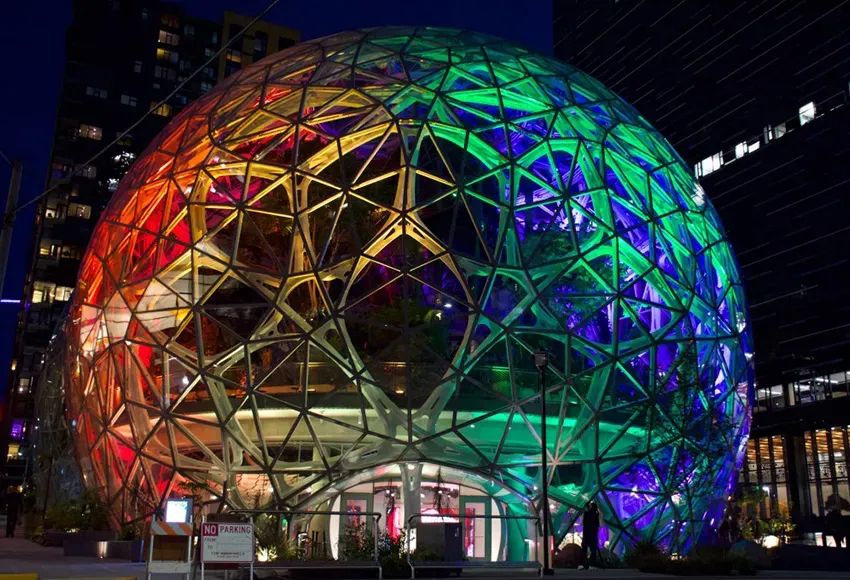Amazon celebrated Prime Day on July 13, reminding residents across the Seattle area that our city truly has become "Amazon town." In recent years, the company has been eager to brand itself as an ally of the LGBTQIA+ community, but with its messy and lackluster execution, Amazon has completely missed the mark. Instead, it's become a case study in rainbow washing and corporate greed.
In case any of us aren't familiar with the term, "rainbow washing" happens when an organization markets itself as a supporter of the LGBTQIA+ community–usually by decorating itself or its products with the rainbow pride flag colors–without doing anything to actually help the community, or perhaps even while harming it.
Corporations across the globe have recently taken up the rainbow washing technique to garner credibility with Queer consumers because, from an economic standpoint, the community is incredibly powerful. According to Forbes, the purchasing power of LGBTQIA+ consumers is near $3 trillion. This is referred to as "pink money," and it made up approximately 14 percent of all disposable income in the U.S. in 2016.
Considering the economic upper hand that Queer buyers have in the U.S., it comes as no surprise that Amazon jumped on this bandwagon when it did. The company's history with rainbow washing is long, and further inspection reveals a trail of empty words and broken promises. As an ally, Amazon has yet to put words into action.
Sure, Prime Video highlights Queer TV, movies and artists, and the shopping website offers opportunities to buy from Queer authors and businesses. This is a good start, but what has Amazon done beyond this? Not much. In fact, when looking back through Amazon's previous business and financial decisions, a deeply anti-Queer sentiment comes to light.
According to a recent report by the New York Times, Amazon began blocking Queer-related searches on its website inside the United Arab Emirates, where homosexuality is illegal. The UAE government had previously threatened Amazon with penalties if it did not comply with the request for censorship. In the face of financial penalty, Amazon completely overlooked an opportunity incite change via Queer advocacy and instead went actively against LGBTQIA+ rights in order to maintain profits.
The company has also seen backlash from its employees for what they describe as anti-Trans behavior on the part of management. According to a report from NBC News, workers led petitions calling for Amazon to stop selling a book called Irreversible Damage: The Transgender Craze Seducing Our Daughter by Abigail Shrier, which frames Queer identity as mental illness and promotes transphobia. After Amazon decided to continue selling the book, two employees resigned. Even here, we see that Amazon chooses profit whenever possible, even if it means ignoring explicit requests from employees to not sell transphobic and anti-Queer material.
Seattle itself has experienced the effects of Amazon's profit greed during Pride month. In her article for Quartz at Work, Lila MacLellan explored the company's recent attempt to sponsor the Seattle Pride Parade, which took place June 26. In return for a $100,000 sponsorship, however, Amazon requested that the event be renamed "Seattle Pride Parade presented by Amazon." Seattle Pride rejected this offer, citing the company's previous donations to anti-LGBTQIA+ lawmakers in recent years and partnerships that AmazonSmile has with approximately 40 anti-LGBTQIA+ organizations and businesses.
Amazon also fails at translating its words into substantial action, a trend best seen in the company's affinity (employee resource) group Glamazon, which centers on employees who are members of the Queer community. Glamazon's 60 active chapters across the country work to "create inclusive workplaces and host hundreds of community events to raise LGBTQIA+ awareness."
What does inclusion in the Amazon world actually look like? When Amazon discusses its open-armed approach to diversity and inclusion, the company, like many others, uses empty words and gives no substantial evidence of any efforts being made. This is a story that the Queer community knows all too well.
Clearly Amazon is not as concerned with Queer advocacy and allyship as it markets itself to be. The company has had several opportunities to create real change with its social and economic status and had repeatedly decided not to for the sake of profit.
Considering the inherently anti-Queer values that Amazon has demonstrated to employees and buyers alike, one is left wondering why and how they continue to get away with these decisions. I believe the answer lies in Amazon's employment rates. According to a Business Insider report, about one in 150 American workers is employed by Amazon. That's about 950,000 people in the U.S. alone; Amazon has about 1.3 million employees worldwide.
It makes sense, then, that Amazon has been able to linger in a place of hypocrisy for years with next to no accountability; many people simply cannot afford to boycott the company. Amazon has placed hundreds of thousands of its employees in a position where they have to choose between boycotting a morally corrupt business or keeping their job. Of course, they need to choose the latter. When an imbalance of power this extreme occurs, control shifts completely to one side, and accountability dwindles as common people lose their voice.
The next step in creating real accountability for Amazon is clear: spend elsewhere. For anyone who can afford to do so, consider buying locally and supporting small businesses (specifically those that are BIPOC-, LGBTQIA+- and/or woman-owned)!
If the pink dollar has shown us anything, it's that purchasing power is a genuine concern for large corporations. If we truly put our money where our mouths are, Amazon will notice, and change will follow.


